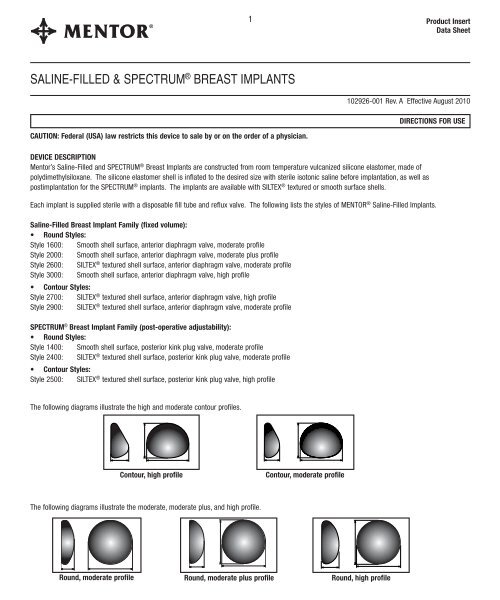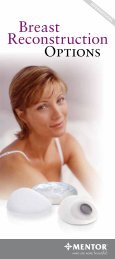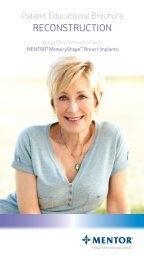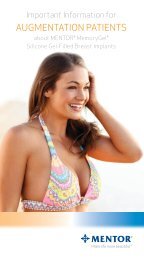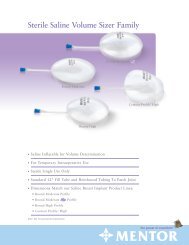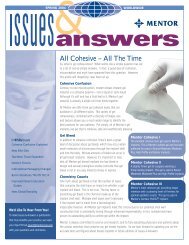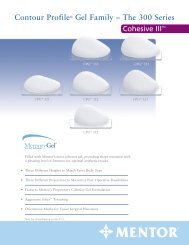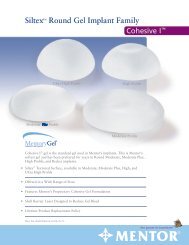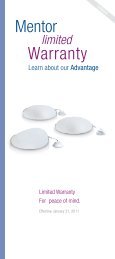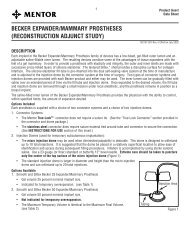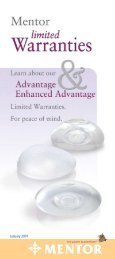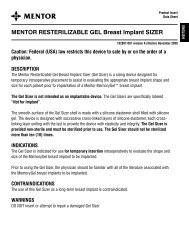SALINE-FILLED & SPECTRUM® BREAST IMPLANTS - Mentor
SALINE-FILLED & SPECTRUM® BREAST IMPLANTS - Mentor
SALINE-FILLED & SPECTRUM® BREAST IMPLANTS - Mentor
You also want an ePaper? Increase the reach of your titles
YUMPU automatically turns print PDFs into web optimized ePapers that Google loves.
4Table 2. SPS: 3-Year Cumulative First Occurrence Kaplan-Meier Adverse Event Risk Rates (95% Confidence Interval), By Patient.Complication Augmentation ReconstructionBy PatientBy PatientN=1264 N=416Rate (%) (95% CI) Rate (%) (95% CI)Wrinkling 20.8% (18.4, 23.2) 20.0% (15.4, 24.5)Reoperation 13.2% (11.2, 15.2) 40.1% (35.0, 45.3)Loss of Nipple Sensation 10.2% (8.4, 12.0) 34.5 % (29.0, 40.0)Capsular Contracture III/IV 9.0% (7.3, 10.7) 30.0% (24.5, 34.8)or grade unknownImplant Removal for 8.1% (6.5, 9.7) 26.8% (22.2, 31.5)Any ReasonAsymmetry 6.7% (5.2, 8.1) 27.9% (23.0, 32.7)Breast Pain 5.1% (3.8, 6.5) 17.2% (12.5, 21.9)Intense Nipple Sensitivity 4.8% (3.5, 6.1)
5Table 3a. SPS: Types of Additional Surgical Procedures through 3 Years for AugmentationOf the 1264 augmentation patients, there were 147 (11.6%) who underwent at least one additional surgical procedure over the 3 years of follow-up inthe SPS. A total of 358 additional surgical procedures were performed in augmentation patients over the 3 years of the SPS. The types of additionalsurgical procedures are shown below based on the number of procedures.Types of Additional Surgical ProceduresN = 358 proceduresfor Augmentation n %Implant Removal with Replacement 116 32%Capsule Related 1 77 22%Scar or Wound Revision 67 19%Reposition Implant 29 8%Saline Adjustment 27 8%Mastopexy 23 6%Implant Removal without Replacement 9 3%Biopsy/Cyst Removal 6 2%Breast Reduction or Mastectomy 3
6Table 4a. SPS: Reasons for Implant Removal through 3 Years for AugmentationOf the 1264 augmentation patients, there were 87 patients (6.9%) who had 137 implants removed over the 3 years of follow-up in the SPS. Of the137 augmentation implants removed, 82% were replaced. The primary reason for implant removal is shown in the table below based on the numberof implants removed.Main Reason for Implant RemovalN = 137 implants Removedthrough 3 Years for Augmentation 1 n %Patient Request for Size/Style Change 50 37%Leakage/Deflation 33 24%Capsular Contracture 25 18%Wrinkling 7 5%Infection 7 5%Asymmetry 5 4%Hematoma/Seroma 3 2%Ptosis 2 2%Hypertrophic Scarring 2 2%Aesthetic Revision 2 2%Breast Cancer 1
9Table 6a. SPS: Reports of CTD through 3 Years for Augmentation, By Patient.Number of Reports of CTD in AUGMENTATION Patients in the SPS StudyRheumatic Disease No. of Confirmed No. of UnconfirmedReports in Patients Reports in PatientsOsteoarthritis 1Rheumatoid Arthritis 1 3Arthritis (type unknown) 15Lupus Erythematosus 1Total 2 19 aa2 aug pts had 2 unconfirmed CTDsTable 6b. SPS: Reports of CTD through 3 Years for Reconstruction, By Patient.Number of Reports of CTD in RECONSTRUCTION Patients in the SPS StudyRheumatic Disease No. of Confirmed No. of UnconfirmedReports in Patients Reports in PatientsOsteoarthritis 2 8Rheumatoid Arthritis 2Arthritis (type unknown) 1 18Ankylosing spondylitis 1Total 4 287 recon pts had 2 unconfirmed CTDsSUBGROUP ANALYSESCox-Regression analyses were performed to identify risk factors for the complications of deflation, capsular contracture (Baker Class III or IV), infection,explantation, and reoperation. Selected significant results of these analyses are summarized below:• Deflation was significantly higher with Betadine ® * surgical pocket irrigation than without.• Capsular contracture (Baker Class III or IV) rate was significantly higher in older than in younger patients.• Capsular contracture (Baker Class III or IV) rates were lower in the inframmary approach in augmentation compared to periareolar.• There was no difference in capsular contracture (Baker Class III or IV) rate for textured versus smooth implants.• SPECTRUM ® Breast Implants were associated with a higher implant removal and reoperation rate compared to the Saline-Filled Breast Implants.4. Effectiveness OutcomeFor augmentation, effectiveness outcomes included breast size change, patient satisfaction, and comfort with appearance. For reconstruction,effectiveness outcomes included breast size change, level of functional living, and depression. These outcomes were reported before implantation andat three years after surgery for those patients who still had at least one of their original implants.For augmentation patients, 955 out of the original 1264 patients (76%) still had implants and were in the study after 3 years. Of these 955 patients,917 (96%) experienced an increase of at least one cup size at 3 years; the average increase in chest circumference was 2.8 inches. Of the 955patients still in the study, 860 (90%) indicated being satisfied with the general appearance of their breasts, as measured by the Breast EvaluationQuestionnaire (BEQ).Most augmentation patients who still had their original implants and were still in the study at 3 years exhibited an improvement in the two measuredsubscales of the Multidimensional Body-Self Relation Questionnaire (MBSRQ) (which measures comfort with your general appearance). Foraugmentation patients, the Tennessee Self-Concept Scale (which measures self-concept) showed a slight increase at 3 years compared to beforeimplantation.For reconstruction patients, 283 out of the original 416 patients (68%) still had implants and were in the study after 3 years. Of these 283 patients, theaverage increase in chest circumference was 1.5 inches.
11The reasons for reoperation through 3, 5, 7 and 10 years are shown in Tables 8 and 9 below. The 3-year data are provided for comparativepurposes because the original labeling only included 3-year types of surgical procedures. For augmentation patients, there were 255reoperations in 146 patients at 3 years, and 343 reoperations in 198 patients at 5 years, 464 reoperations in 259 patients at 7 years, and 646reoperations in 347 patients at 10 years. For reconstruction patients, there were 209 reoperations in 149 patients at 3 years, 232 reoperationsin 162 patients at 5 years, 279 reoperations in 185 patients at 7 years, and 313 reoperations in 202 at 10 years. Although the percentages aredecreasing across the timepoints, it is because there has been an increase in the number of reoperations.Table 8: Reasons for Reoperation in Augmentation PatientsReason for Reoperation 1 3 Years 5 Years 7 Years 10 YearsN = 255 N=343 N=464 N=646Reoperations Reoperations Reoperations ReoperationsPatient Request for Size/Shape Change 84 (32.9%) 98 (28.6%) 113 (24.2%) 137 (21.2%)Capsular Contracture 49 (19.2%) 58 (16.9%) 69 (14.9%) 86 (13.3%)Leakage/Deflation 2 36 (14.1%) 66 (19.2%) 129 (27.8%) 196 (30.3%)Wrinkling 30 (11.8%) 38 (11.1%) 45 (9.7%) 59 (9.1%)Asymmetry 25 (9.8%) 27 (7.9%) 28 (6.0%) 37 (5.7%)Ptosis 23 (9.0%) 32 (9.3%) 36 (7.8%) 41 (6.3%)Hypertrophic Scarring 22 (8.6%) 22 (6.4%) 22 (4.7%) 22 (3.4%)Hematoma/Seroma 15 (5.9%) 15 (4.4%) 4 15 (3.2%) 15 (2.3%)Infection 14 (5.5%) 15 (4.4%) 15 (3.2%) 15 (2.3%)Aesthetic Revision 13 (5.1%) 15 (4.4%) 5 16 (3.4%) 17 (2.6%)Breast Mass/Tumor/Cyst Excisionor Biopsy 7 (2.7%) 15 (4.4%) 3 22 (4.7%) 34 (5.3%) 3Breast Pain 3 (1.2%) 3 (0.9%) 3 (0.6%) 3 (0.5%)Delayed Wound Healing 2 (0.8%) 2 (0.6%) 2 (0.4%) 2 (0.3%)Irritation/Inflammation 2 (0.8%) 2 (0.6%) 2 (0.4%) 2 (0.3%)Extrusion 2 (0.8%) 2 (0.6%) 2 (0.4%) 2 (0.3%)Lymphadenopathy 1 (0.4%) 1 (0.3%) 1 (0.2%) 1 (0.2%)Contralateral Replacement 0 (0.0%) 11 (3.2%) 35 (7.5%) 66 (10.2%)Other 0 (0.0%) 0 (0.0%) 0 (0.0) 9 (1.3%) 61If there was more than one reason reported per patient, all reasons are included in this table. 2Includes 11 reoperations where deflation is assignedas worst case when the reason was not reported at 3, 5, 7 and 10 years. Includes one fill tube failure at 7 years. 3 Includes 24 breast mass/cancer, 4fibroid tumors, and 5 mole/cyst removal, 1 biopsy cases. 4Includes 11 hematoma and 4 seroma cases. 5Includes dimpling on pectoral muscle, reviseinframammary, position/shape change, and trauma. 6 Includes 4 prophylactic implant removal, 2 allergic reaction, 1 atypical ductal hyperplasia, 1sclerosing adenosis, 1 prophylactic mastectomy.
Table 9: Reasons for Reoperation in Reconstruction Patients12Reason for Reoperation 1 3 Years 5 Years 7 Years 10 YearN = 209 Reoperations N=232 Reoperations N=279 Reoperations N=313 ReoperationsCapsular Contracture 63 (30.1%) 67 (28.9%) 85 (30.5%) 90 (28.8%)Asymmetry 45 (21.5%) 47 (20.3%) 48 (17.2%) 52 (16.6%)Patient Request for Size/Shape Change 33 (15.8%) 37 (15.9%) 43 (15.4%) 43 (13.7%)Staged Reconstruction 33 (15.8%) 35 (15.1%) 2 33 (11.8%) 33 (10.5%)Infection 33 (15.8%) 34 (14.7%) 34 (12.2%) 36 (11.5%)Leakage/Deflation 7 27 (12.9%) 35 (15.1%) 52 (18.6%) 59 (18.8%)Delayed Wound Healing 18 (8.6%) 18 (7.8%) 18 (6.5%) 18 (5.6%)Breast Pain 17 (8.1%) 17 (7.3%) 20 (7.2%) 20 (6.4%)Hematoma/Seroma 16 (7.7%) 16 (6.9%) 3 16 (5.7%) 16 (5.1%)Hypertrophic Scarring 13 (6.2%) 13 (5.6%) 14 (5.0%) 14 (4.5%)Wrinkling 12 (5.7%) 12 (5.2%) 13 (4.7%) 13 (4.2%)Extrusion 9 (4.3%) 10 (4.3%) 10 (3.6%) 10 (3.2%)Necrosis 9 (4.3%) 9 (3.9%) 9 (3.2%) 9 (2.9%)Aesthetic Revision 9 (4.3%) 9 (3.9%) 4 9 (3.2%) 10 (3.2%)Irritation/Inflammation 8 (3.8%) 8 (3.4%) 8 (2.9%) 8 (2.6%)Breast Mass or Cancer 4 (1.9%) 5 (2.2%) 6 (2.2%) 12 (3.8%) 5Valve Malposition 1 (0.5%) 1 (0.4%) 1 (0.4%) 1 (0.3%)Lymphadenopathy 1 (0.5%) 1 (0.4%) 1 (0.4%) 1 (0.3%)Ptosis 0 (0.0%) 2 (0.9%) 2 (0.7%) 5 (1.6%)Contralateral Replacement 0 (0.0%) 1 (0.4%) 4 (1.4%) 6 (1.9%)Position Change 0 (0.0%) 0 (0.0%) 1 (0.4%) 3 (1.0%)Other 0 (0.0%) 0 (0.0%) 0 (0.0%) 2 (0.6%) 61If there was more than one reason reported per patient, all reasons are included in this table. This table excludes patients in which stagedreconstruction was the only reason for reoperation. 2 These patients reported both staged reconstruction and other reason(s). See footnote 1 above.3Includes 4 hematoma and 12 seroma cases. 4Includes dimpling on pectoral muscle, revise inframammary, position/shape change, and trauma.5Includes 1 removal of axillary lymph notes. 6 Includes 1 prophylactic mastectomy, 1 prophylactic implant removal. 7 Includes 1 reoperation where deflationis assigned as worst case when the reason was not reported at 10 years.The main reasons for implant removal through 5, 7 and 10 years are shown in Tables 10 and 11 below. At 5 years, there were 211 implants removedin 132 augmentation patients, and 135 implants removed in 112 reconstruction patients. At 7 years, there were 324 implants removed in 191augmentation patients, and 180 implants removed in 142 reconstruction patients. At 10 years, there were 487 implants removed in 272 augmentationpatients, and 206 implants removed in 158 reconstruction patients. Although the percentages are decreasing across the timepoints, it is because therehas been an increase in the number of implants removed.Table 10: Primary Reason for Implant Removal through 5 years for Augmentation PatientsPrimary Reason for Removal 5 Years 7 Years 10 YearsN = 211 implants Removed N=324 Implants Removed N=487 Implants RemovedPatient Request for Size/Shape Change 63 (29.9%) 78 (24.1%) 102 (20.9%)Leakage/Deflation 1 63 (29.9%) 125 (38.6%) 189 (38.8%)Capsular Contracture 31 (14.7%) 38 (11.7%) 53 (10.9%)Wrinkling 13 (6.2%) 18 (5.6%) 27 (5.5%)Contralateral Replacement 10 (4.7%) 32 (9.9%) 63 (12.9%)Infection 8 (3.8%) 8 (2.5%) 8 (1.6%)Asymmetry 7 (3.3%) 7 (2.2%) 15 (3.1%)Breast Mass or Cancer 4 (1.9%) 5 (1.5%) 6 (1.2%)Aesthetic Revision 4 (1.9%) 5 (1.5%) 6 (1.2%)Ptosis 3 (1.4%) 3 (0.9%) 6 (1.2%)Hematoma/Seroma 3 (1.4%) 3 (0.9%) 3 (0.6%)Hypertrophic Scarring 2 (0.9%) 2 (0.6%) 2 (0.4%)Other 0 (0.0%) 0 (0.0%) 7 (1.4%) 21Includes 9 removals where deflation is assigned as worst case when the reason for removal was not reported at 5, 7 and 10 years. Includes onefill tube failure at 7 years. 2 Includes 3 prophylactic implant removal, 2 fibroid tumors, 2 allergic reaction.
13Table 11: Primary Reason for Implant Removal through 5 years for Reconstruction PatientsPrimary Reason for Removal 5 Years 7 Years 10 YearsN=135 Implants Removed N=180 Implants Removed N=206 Implants RemovedCapsular Contracture 39 (28.9%) 52 (28.9%) 56 (27.2%)Leakage/Deflation 34 (25.2%) 51 (28.3%) 57 (27.7%)Infection 29 (21.5%) 29 (16.1%) 31 (15.0%)Patient Request for Size/Shape Change 11 (8.1%) 17 (9.4%) 17 (8.3%)Necrosis/Extrusion 7 (5.2%) 7 (3.9%) 7 (3.4%)Asymmetry 5 (3.7%) 7 (3.9%) 11 (5.3%)Breast Pain 4 (3.0%) 4 (2.2%) 4 (1.9%)Breast Mass or Cancer 2 (1.5%) 3 (1.7%) 4 (1.9%)Delayed Wound Healing 2 (1.5%) 2 (1.1%) 2 (1.0%)Wrinkling 1 (0.7%) 1 (0.6%) 1 (0.5%)Aesthetic Revision 1 (0.7%) 1 (0.6%) 2 (1.0%)Contralateral Replacement 0 (0.0%) 3 (1.7%) 5 (2.4%)Position Change 0 (0.0%) 1 (0.6%) 3 (1.5%)Ptosis 0 (0.0%) 0 (0.0%) 2 (1.0%)Hypertrophic Scarring 0 (0.0%) 1 (0.6%) 1 (0.5%)Irritation/Inflammation 0 (0.0%) 1 (0.6%) 1 (0.5%)Other 0 (0.0%) 0 (0.0%) 2 (1.0%) 11Includes 1 prophylactic implant removal and 1 prophylactic mastectomy.Instructions for UseNOTE: It is advisable to have more than one size breast implant in the operating room at the time of surgery to allow for flexibility in determining theappropriate size implant to be used. A backup implant should also be available.Do Not stack more than one implant per breast pocket.Recording ProcedureEach prosthesis is supplied with two Patient Record Labels showing the catalog number and lot number for that unit. One of these pressure-sensitivelabels should be attached directly to the Patient ID Card, and one to the patient’s chart. The implanted position (left or right side) and the fill volume ofeach prosthesis should be indicated on the label.SterilizationSILTEX ® and smooth-surface saline-filled breast implants are provided sterile. They are sterilized by either gamma radiation or dry heat. The exactmethod can be determined by the sterilization symbol on the outer packaging. This product is for single use only.Do not resterilize.Implant SelectionSome of the important surgical and implant sizing variables that have been identified include the following:• The implant should not be too small or too large in comparison to the patient’s chest wall dimensions.• Available tissue must provide adequate coverage of the implant.• Submuscular placement of the implant may be preferable in patients with thin or poor quality tissue.• A well-defined, dry pocket of adequate size and symmetry must be created to allow the implant to be placed flat on a smooth surface.• Avoid too small of an incision.• The higher profile of the SILTEX ® shell should be considered in surgical approach.
18SMOOTH & SILTEX ® SPECTRUM ® INFLATION TABLESILTEX ® Smooth Temporary* Final FinalCatalog Catalog Device Minimum Minimum MaximumNumber Number Volume (cc) Volume (cc) Volume (cc) Volume (cc)354-2410M 350-1410 125 105 125 150354-2420M 350-1420 175 150 175 210354-2430M 350-1430 225 190 225 270354-2440M 350-1440 275 230 275 330354-2450M 350-1450 325 275 325 390354-2460M 350-1460 375 320 375 450354-2470M 350-1470 425 360 425 510354-2480M 350-1480 475 400 475 570350-1485 525 445 525 630350-1490 575 490 575 690* Temporary Minimum Volume must not exceed 90 days.SILTEX ® CONTOUR PROFILE ® SPECTRUM ® INFLATION TABLETemporary* Final FinalCatalog Device Minimum Minimum MaximumNumber Volume (cc) Volume (cc) Volume (cc) Volume (cc)354-2511 275 235 275 330354-2512 350 300 350 420354-2513 450 380 450 540354-2514 550 470 550 660354-2515 650 550 650 780* Temporary Minimum Volume must not exceed 90 days.POSTOPERATIVE CARE<strong>Mentor</strong> recommends that the patient be wrapped superiorly with an elastic (Ace) bandage, taped laterally, and wear a surgical bra 24 hours a day tohelp prevent shifting of the implant.DEVICE RETRIEVAL EFFORTS<strong>Mentor</strong> requests that any explanted devices be sent to <strong>Mentor</strong>, Product Evaluation Department, 3041 Skyway Circle North, Irving, TX 75038 USA forexamination and analysis.PRODUCT EVALUATION<strong>Mentor</strong> requires that any complications or explantation resulting from the use of this device be brought to the immediate attention of your local <strong>Mentor</strong>representative, who will be responsible for informing the Product Evaluation Department at <strong>Mentor</strong>, 3041 Skyway Circle North, Irving, TX 75038 USA.RETURNED GOODS AUTHORIZATION• U.S. CustomersMerchandise returned must have all manufacturers seals intact and must be returned within 60 days from date of invoice to be eligible for creditor replacement. Please contact <strong>Mentor</strong> Customer Service Department for details. Returned products may be subject to restocking charges.• International CustomersAuthorization for return of merchandise should be obtained from your respective <strong>Mentor</strong> representative. Other conditions noted above also apply.
19Information a Physician Should Provide to the PatientBreast implantation is an elective procedure and the patient must be well counseled on the risk-benefit relationship. The surgeon should provide eachprospective patient with the following:• Saline-Filled Breast Implant Surgery: Making an Informed Decision.This brochure can be used to facilitate patient education in the risks and benefits of saline-filled breast implant surgery. The patient should beadvised to wait a week after reviewing and considering this information before deciding whether to have augmentation surgery.• Patient ID CardEnclosed with each saline-filled breast implant is a Patient ID Card. To complete the Patient ID Card, stick one Patient Record Label for eachimplant on the back of the Patient ID Card. Patient Record Labels are located on the internal product packaging attached to the label. If a PatientRecord Label is unavailable, the lot number, catalog number and description of the device may be copied by hand from the device label. Thepatient should be provided with the Patient ID Card for personal reference.PRODUCT ORDER INFORMATIONU.S. CustomersTo order directly in the USA, please contact the <strong>Mentor</strong> Customer Service Department at <strong>Mentor</strong>, 201 <strong>Mentor</strong> Drive, Santa Barbara, CA 93111; Toll freetelephone (800) 235-5731, FAX (805) 967-7108.International CustomersFor product information or to order directly, contact your local <strong>Mentor</strong> representative or the International Customer Service Department at <strong>Mentor</strong>, 201<strong>Mentor</strong> Drive, Santa Barbara, CA 93111 USA; (805) 879-6000; FAX (805) 967-7108.REFERENCESLiterature references are available upon request from:<strong>Mentor</strong> Marketing Services, Literature Department201 <strong>Mentor</strong> DriveSanta Barbara, CA 93111 USA
20NOM.DIM.Nominal Dimensions2STERILIZEDo not resterilizeMIN.VOL.Minimum Volume final (cc)RMIN.DIM.QTY 1SSLMinimum DimensionsQuantityStyleStyle: nnnn RoundBreast; Right (or) LeftLATEX•••••••••••••••••••••••••••••••••••Latex freeNot returnable if openedFluid addedDateMAX.VOL.STERILE &NONPYROMaximum Volume final (cc)The enclosed device is sterile and nonpyrogenic(unless the package has been opened or damaged).For customer service or to return product, please call(800) 235-5731 in USA; or outside of USA, call(805) 879-6000, or contact your local representative.®For customer service, please call (800) 235-5731 in USA;or outside of USA, call (805) 879-6000, or contact yourlocal representative.www.mentorwwllc.com • www.mentordirect.comManufacturerMENTOR3041 Skyway Circle NorthIrving, TX 75038-3540USAEuropean Representative<strong>Mentor</strong> Medical Systems B.V.Zernikedreef 22333 CL, LeidenThe Netherlands+ 31-71-75136000 0 8 6


